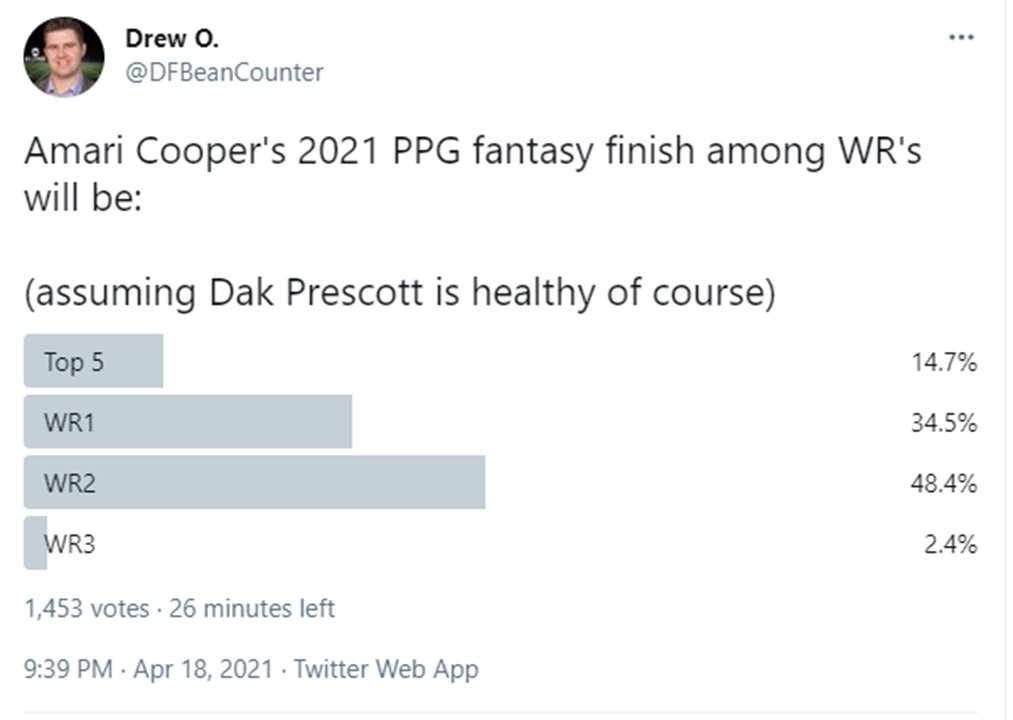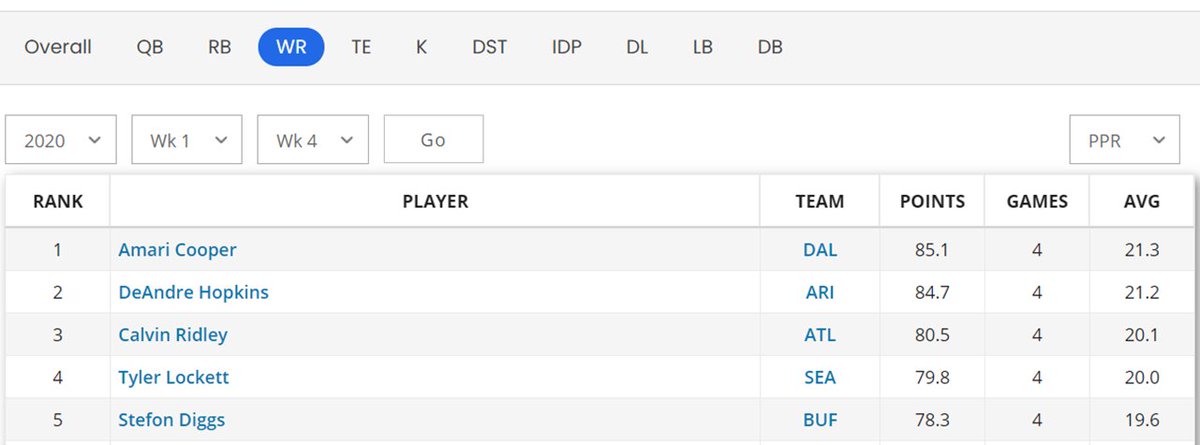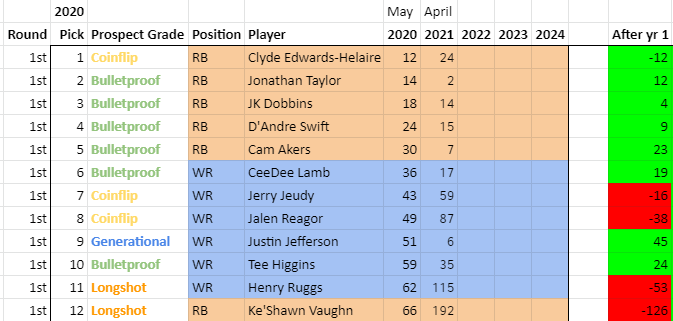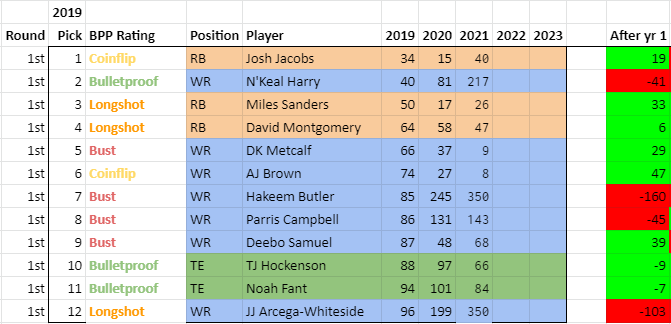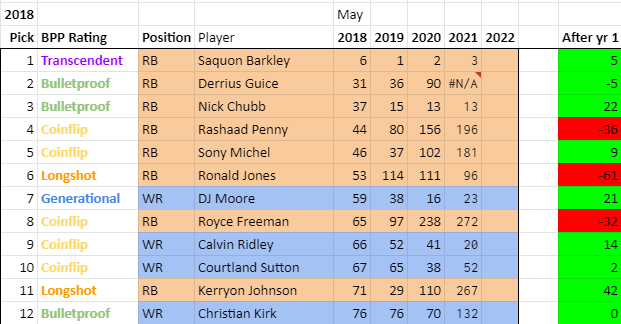
I was working my draft guide and was thinking about what would have had to have changed for Devonta in order for him to qualify as Bulletproof.
Let's Dive In.
Let's Dive In.
He'd have had to have declared for the draft last year and not have been held back by the likes of Henry Ruggs in his age 19 season.
Here are the flaws.
Senior
Age 22 rookie
Age 20 breakout age
Consistent excellence (didnt hit enough production benchmarks)
Here are the flaws.
Senior
Age 22 rookie
Age 20 breakout age
Consistent excellence (didnt hit enough production benchmarks)
So here are all of the first round Coinflips (because we are assuming he CANNOT qualify for Bulletproof).
But these are ONLY the ones that DOMINATED throughout college. So this would be if Devonta had not been held back by Henry Ruggs in his early years.
But these are ONLY the ones that DOMINATED throughout college. So this would be if Devonta had not been held back by Henry Ruggs in his early years.

Ok, now ONLY looking at the guys that consistently dominated... let start filtering, this one is the seniors. 

Ok, but what if Devonta was an early declare!?
That's slightly better. At least DT is on this list! far from a cure for the Devonta profile though.
That's slightly better. At least DT is on this list! far from a cure for the Devonta profile though.

But I guess if Devonta had consistent domination (which we are assuming in this example) that would make him an early breakout!
so lets flip it to age 18 and 19 breakouts.
hmmm.
so lets flip it to age 18 and 19 breakouts.
hmmm.

ok, this is getting us nowhere fast. Lets change the game
Instead of assuming he consistently dominatd lets go with his actual production profile which actually still fits in the Coinflip tier
These are Coinflips that didnt produce as much as we'd have liked (just like Devonta)
Instead of assuming he consistently dominatd lets go with his actual production profile which actually still fits in the Coinflip tier
These are Coinflips that didnt produce as much as we'd have liked (just like Devonta)

Ok.... But lets now switch it to juniors and give Devonta the benefit of the doubt that he could have declared early last year and been a first round pick. 

Ok, now we are removing the senior/junior filter and are tackling breakout age.
Here are the guys with an age 20 breakout age.
Here are the guys with an age 20 breakout age.

But Devonta *could* have broken out at 18 or 19 if he didnt play at Alabama so lets flip it to them. 

Devonta would need to gain 30 pounds to qualify for alpha status, but lets presume that EVERYONE else's weight was inflated at the combine due to water weight and the only legitimate non-water inflated weight was Devonta's 166 pounds.
So our assumption is that he is closer to alpha than the weigh-ins would lead us to believe.
The Alphas tend to hit a lot when they hit in this range.
The Alphas tend to hit a lot when they hit in this range.
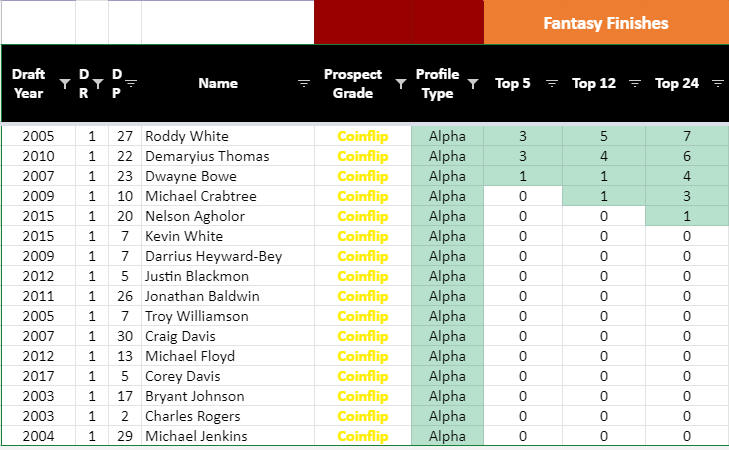
IF Devonta's 166 is in fact real, as is everyone else's weigh-in... Here are the Coinflip Betas
The hits tend to be one-hit wonders so far... And Calvin Ridley of course
I also thought I fixed it but it looks like his top 5 finish from last season is missing. Pretend its there
The hits tend to be one-hit wonders so far... And Calvin Ridley of course
I also thought I fixed it but it looks like his top 5 finish from last season is missing. Pretend its there

So like, Devonta would have been a much better prospect IF the following would have happened.
Henry Ruggs didnt hold him back from breaking out at 19.
He was an early declare
He dominated consistently
And he was an age 21 rookie...
Henry Ruggs didnt hold him back from breaking out at 19.
He was an early declare
He dominated consistently
And he was an age 21 rookie...
So in summary, if he was a totally different prospect, he'd be a lot better prospect.
Until then, he will remain a Coinflip and no amount of configuring will change that.
Until then, he will remain a Coinflip and no amount of configuring will change that.

If you are into a bunch of useless but fun analysis like this, I went through this with the patrons a month or two ago. 🤣
Sign up at Patreon.com/BulletproofFF if that's your jam.
Sign up at Patreon.com/BulletproofFF if that's your jam.
• • •
Missing some Tweet in this thread? You can try to
force a refresh






